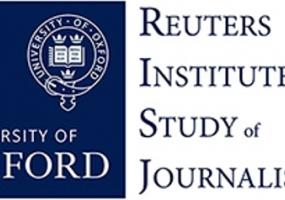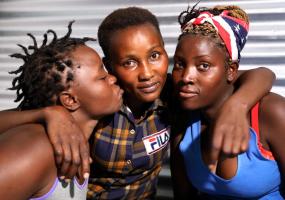Seminar report: Reporting Africa: New Storytellers, New Stories
07 Mar 2017
Africa is rising and its narrative is evolving rapidly; Mel Bunce says that the days of reporting the continent through a lens of suffering, famine, war and catastrophe are receding or, at least, significantly tempered by shifting narratives of economic growth and social change that feature a wider diversity of voices and perspectives.
Bunce’s book is the first in almost 25 years to re-engage with the way Africa is presented in the international media; bringing together research from academics, journalists, and foreign correspondents and diverse analysis of news media over the last two decades. It examines what may be driving the change in storytelling, who these new storytellers are and how they work.
Talking about the book and drawing on the body of work from her PhD thesis and post-doctorate work, Bunce explained how three major themes have emerged in Africa’s global media image: news content is changing and becoming more positive; the storytellers, or ‘who does the reporting’ is changing; and the addition of social media to the news narrative has had a big impact on the dynamics.
Africa’s developing news profile is meaningful – one of the most prevalent critiques of international news coverage of Africa is that, historically, it has been overwhelmingly ‘Afro-pessimistic’; charting famine, natural disasters, conflict, humanitarian crises and predicting that this is unlikely to get better in the future. The danger of this homogenous ‘single story’, as explained by Nigerian author Chimamanda Ngozi Adichie in her TED Talk, is that it creates a false impression of people and place that can build an unbalanced and harmful narrative.
Bunce contends this neo-colonial discourse damages intercultural understanding and creates a narrative where Africa needs to be 'saved' by external forces. News reports like Michael Buerk’s British news feature on the famine in Ethiopia, which didn’t give a non-European the opportunity to speak, was criticized for its ‘white saviour’ stereotype, depoliticising the drivers of the disaster while erasing local efforts to help.
But the media began to shift dramatically in 2010 – a ‘sea change’ Bunce notes in the modification in language and tone used to describe the continent in certain contexts: The Economist published an Africa Rising cover, soon the New York Times and TIME magazine followed with similar stories. International Organisations like the IMF and World Bank were quick to move on this shift and began promoting press conferences heralding the rise of Africa. As one journalist noted in Bunce’s book, “…it’s fashionable these days to be upbeat about Africa”.
Looking at some of the biggest wire services in Africa over that time; AP, AFP and Reuters, Bunce notes that between the late 1990s and early 2010s the reporting on humanitarian crises went from 17.3% of all news coverage down to 1.9% (the latter all focused on refugee issues) while business reporting rose significantly from 20% of all reporting to 36% during that time.
Looking at key global newspapers, The New York Times, Globe & Mail, The Sydney Morning Herald and the Guardian, positive reporting of African issues and themes over that period went from 11% to 29%, and negative content dropped from 53% to 32%. At the Guardian in 2013 there were actually more positive stories about Africa than there were negative ones (33 vs 32%).
The reason behind these changes would seem to be Africa’s economic boom, though there was also a change in which media outlets were on the ground. Since the 1990s, newsroom cuts have led to a decrease in correspondents on the continent. This coincided with the rise of business journalism and Reuters repositioning itself as a more finance-focused news organisation. These changes had a ripple effect that pushed the wire services to generate the bulk of news content, which inevitably tended to focus on business and markets.
But while the narrative has shifted, Bunce says that the neo-colonial language has not changed much – Africa is not suffering perpetually, but it is still represented as ‘there for the taking’, most apparent when news reports focus on China and Europe in Africa and the jostle for control of its abundant natural resources.
Africa’s lineup of storytellers has changed too – poorly resourced newsrooms have led to a need to employ local journalists. These reporters are usually from the country (or even the community) they are reporting on, and well-placed to get an accurate picture of the situation on the ground. Though these additional narratives can be constrained, since these reporters still cater to editors in foreign newsrooms with western audiences, the addition of these diverse voices and perspectives is noteworthy.
The addition of new, well-resourced media outlets like Al Jazeera and CCTV has also had impact: Al Jazeera has positioned itself as the voice of the global south, searching out diverse perspectives while employing sensitivity towards reporting on incendiary local issues. CCTV, meanwhile, has become one of the best resourced networks in Africa and has reported extensively on Africa’s economies while tailoring the news on violent conflict. It’s a new kind of ‘consensus journalism’ that approaches news on the continent through a different lens.
News media and foreign correspondents appear to be increasingly aware of the communities they report on within Africa, viewing them as audiences, not simply an issue or place to report on for audiences at home. Social media has impacted this– in recent news cycles we have seen hashtags like #SomeoneTellCNN, a humorous attempt at correcting gross oversights in the headlines of the major news network as it portrayed the entire continent as a ‘hotbed of terrorism’ or confused violence in smaller communities with widespread regional warfare. The Twitter campaign prompted retractions and apologies, but also highlighted that African audiences were becoming active consumers of the news and would be demanding fairer representation.
Bunce adds that the changing narrative for Africa and the introduction of new storytellers are developments that should be watched closely – searching out only positive stories (particular when they’re favoured by independent journalism financiers like the Gates Foundation or similar wealthy NGOs) can also skew the continent’s narrative, and while new voices do feature now in the African media landscape there is still the danger of ‘the single story’ unless many diverse viewpoints are also given due consideration and prominence.
Mel Bunce, senior lecturer in Journalism, City University, co-editor of Africa's Media Image in the 21st Century was speaking at an RISJ seminar on February 15, 2017.





